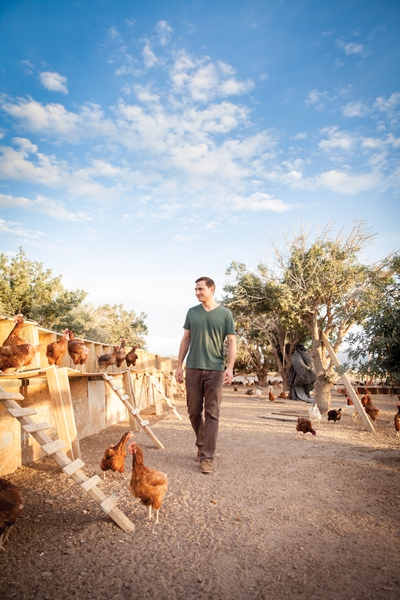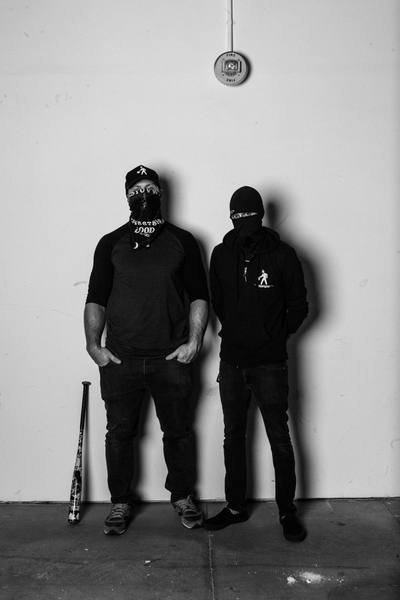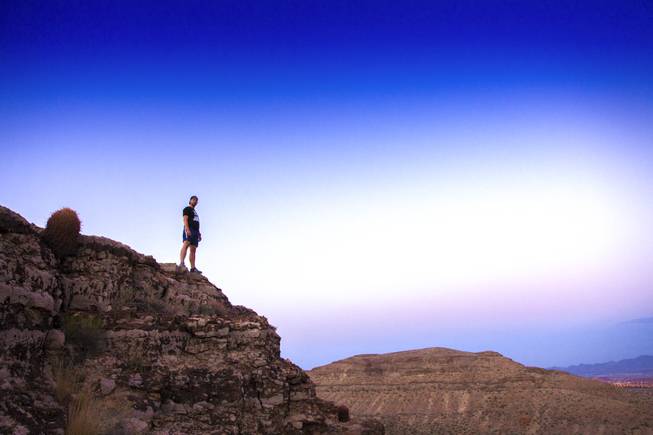
Jon Estrada/Special to The Sunday
Rob Erekson heads Desert Dash, a company that promotes trail running.
Monday, June 12, 2017 | 2:01 a.m.
Forget the obvious.
Adventure is the domain of the bold working in any discipline.
They break molds, conventions and new ground. They might even break the law to make a statement, or a difference.
Whatever you think of their goals or methods, these individuals have guts and vision.
Rob Erekson, Stephen Massey, Joshua Eddy and Aaron Hastings
• Organization: Desert Dash
• Mission: Spreading the gospel of trail running
Holding up his own scarred hand with a grin, Rob Erekson recalls a gash in Joshua Eddy’s arm that needed 15 stitches.
“Everybody’s going to fall, and you’re gonna bleed,” Erekson says of running the desert trails of Southern Nevada, with the “vicious” terrain, punishing heat and occasional homicidal cactus.
“You go to Oregon or Northern California and it’s beautiful dirt, pillowy and buttery. And you’re in the trees; there’s no harsh sun,” Eddy says. “Out here, things attack your ass.”
That’s part of the allure for runners who find peace, empowerment and sweaty good times in testing themselves against the landscapes of Bootleg and Sloan canyons and the Cottonwood Valley, all showcased in annual races put on by Desert Dash.
Erekson has been an owner of the 17-year-old company since 2013. He remembers when its flagship event, Blood, Sweat & Beers, drew maybe 80 locals to Bootleg. Now it’s bringing 700 from all over the West for 5Ks up to full marathons.
That distance diversity will remain, but Erekson says new partners Stephen Massey, Aaron Hastings and Eddy are fueling the plan to expand the company’s ultra category, from 31 miles up to 100.
“We’ve been able to bring a lot of people in who were 5K runners or less and were really nervous about trail running, and we built them up,” says Hastings, whose first race with Desert Dash was 6.2 miles in the 2013 Henderson Trail Classic. Now he’s tackling five times that distance, making sure to do a dance whenever he hits the marathon mark and knows he still has miles to go. “Why do I want to run harder and more? The personal challenge of taking on something that normal people would look at and say, ‘You’re just downright crazy.’ ”
Hastings says running saved his life, and he shares his story with newbies showing up to the group’s casual run every Wednesday. In just over two years, more than 2,000 people have joined the Facebook page, and Eddy says it’s the first time he has seen the trail community formally jell.
Desert Dash is keen to keep it growing, as a race company and as an advocacy group pushing for access. The owners are looking at expanding their footprint beyond the valley to the trail systems of Beatty and Caliente, as well as getting the word out that Southern Nevada has outdoor splendor and a welcoming scene of "trail junkies" (known to race dressed like Elvis or maybe a pack of unicorns). Erekson says the message is meant just as much for locals with no experience as it is for hardcore runners across the country.
"I don’t think people realize what they’re capable of. I used to think running a marathon was gonna be a bucket-list thing. Now I’m like, cool, let’s go do some longer runs. ... A little bit at a time," he says.
"The goal, whether it be difficulty or beautiful races, is just to create a great experience," Massey says. "As people’s mindset shifts away from just acquiring things to experiencing things instead, that’s something we definitely try and provide."
Take Bootleg Beatdown, coming up June 17, when temperatures in Las Vegas are guaranteed to be extreme. Massey, who runs 100-milers, calls the 3.1-mile course “extremely difficult.”
“It’s a 1,000-foot climb in three-quarters of a mile. It’s brutal, insanely technical. It’s hot,” Erekson says, adding that there are spots where competitors use hands and feet to scramble over rocks.
Why do it? When you prove yourself on something that feels epic, Massey says, “you get a new perspective; you don’t get as stressed. For me, it is very meditative to be out there.”
Release. Control. Training for life’s painful slogs. And the simple joy of getting caked with dirt among the converted.
Brett Ottolenghi
• Organization: Artisanal Foods
• Mission: Transforming the food system
Brett Ottolenghi doesn’t carry whole ham legs through casinos anymore. His quest to purify the American diet has expanded from restaurant plates to the political arena and Florida’s lionfish-infested waters alike.
Not content to be a purveyor of artisanal, sustainable foods, he has become a producer and tenacious advocate who still finds time for related adventures (like wading into ice-cold Japanese creeks to pick wasabi to grate on sharkskin for visitors of his Las Vegas shop).
His pursuits have taken him to Spain for saffron, to Tunisia for olives, to China for Jinhua ham and to the Colorado hinterlands to connect with a farmer hell-bent on using bison herds to turn deserts back into prairies. Along with some beautiful food, Ottolenghi has found widespread “cheating” — cutting the quality of product in pursuit of profit.
"I started out at the high end of food, wondering: Is it only these high-end foods where there’s so much adulteration? But it’s everything," he says. “You find that even the most mundane ingredient, like mozzarella cheese, turns out to be one of the biggest scams there is."
Rather than retreat into his own little curated world, Ottolenghi is traveling the country for a book about exceptional food pioneers. He’s talking with state representatives of the U.S. Department of Agriculture about pathways to a mobile slaughterhouse that could “transform the possibilities of farming” in Nevada. In industry circles, he’s making cases for eating invasive fish and feeding farmed species with protein-rich black soldier flies. He still attends the occasional Nevada Dairy Commission meeting to move the needle on legalizing raw milk. And he launched his Vegas Food Expo in March, featuring 135 innovative companies "poised to be discovered," with a goal of 250 for next year.
Top of mind is Artisanal Farms, a 40-acre pistachio grove about an hour northwest of Las Vegas housing what may be the world’s happiest chickens. The goal is to make the perfect egg, starting with letting the jungle foul roost in trees and eat natural feed grown onsite that contains no corn or soybeans. About 1,000 heritage hens are laying organic blue and brown eggs you can buy at Ottolenghi’s shop, PublicUs and Glazier’s Food Marketplace, and the farm will soon add 4,000 birds toward the break-even goal of 20,000.
“There’s this myth that only conventional agriculture can feed the world. ... One reason for doing this egg farm at scale is to dispel that idea. It’s not exactly a mom-and-pop farm, yet we have not cut any corners, there’s been no detriment to animal welfare — the chickens are living as well as they could. So I think that’s the point. We need consumers to pay the true cost of food rather than the farm animals ...” Ottolenghi says. “I’m trying to push food forward on many fronts. All of my projects support the central core of just facilitating a better food system.”
-
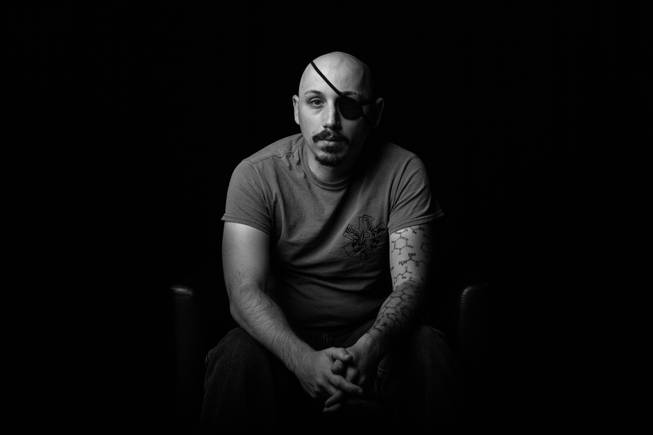
Robert Hoey
Robert Hoey
• Organization: Shadows of Hope
• Mission: Helping the vulnerable (by any means necessary)
In unstable regions throughout the world, areas can be deemed too dangerous for aid workers. They are pulled out by their organizations — or forced out by militant governments — leaving victims of war, genocide or famine without much-needed relief.
That’s when Robert Hoey gets interested.
He built his Las Vegas-based nonprofit, Shadows of Hope, on a willingness to go where others can’t, or won’t, and do whatever is needed. Volunteers, ranging from doctors and social workers to former special forces, have completed missions in more than a dozen countries, including Syria and Iraq. They’ve set up clinics on battle lines, snuck into forbidden areas for intel and shot back when combatants shot at them.
It’s an approach some in the humanitarian world see as reckless and inappropriate, but Hoey and his team believe if they don’t step in and do what they can, nobody will. Most volunteers are former military fueled by the frustration of witnessing injustices but being hamstrung by protocols.
Hoey admits to breaking laws to serve missions. The nonprofit’s website says it works with whoever is helpful, “from authorities in the highest government office to lowly pirates and thieves.” He says he feels no regret about crossing lines, giving the example of smuggling a journalist into a region with a media blackout.
“There is a gray area that we operate in. That’s OK. Nobody is clean,” he says. “The Army isn’t clean. The CIA isn’t clean. Shadows of Hope isn’t. ... But at least we’re not doing it for money or land. We’re just there because people need help.”
In July, volunteers plan to embark on a three-month mission to parts of Indonesia, Pakistan and India. The goal is to fact-find and offer aid to vulnerable groups in remote or restricted areas (in Indonesia’s West Papua, for instance, Hoey says people have reached out about genocide happening inside a military zone).
Hoey believes this work is important enough to compromise his own health. He has lost an eye, three teeth and part of his left leg to injuries sustained overseas. In the back of his mind, he wonders if he might die for this. “But to see the stuff I’ve seen … I can’t not do anything.”
-
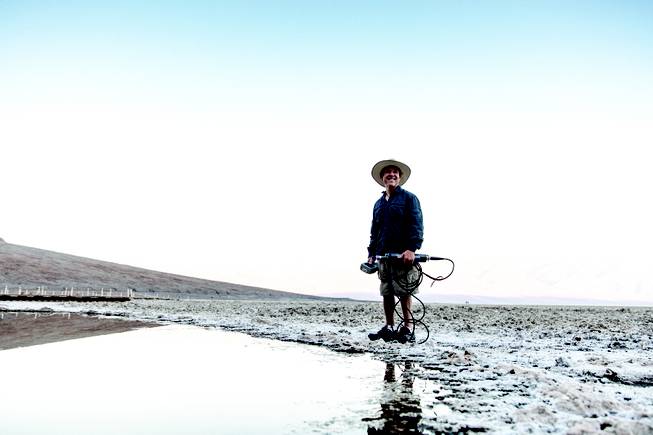
Brian Hedlund
Brian Hedlund
• Organization: UNLV School of Life Sciences
• Mission: Exploring microbial dark matter
“I tell them to never turn their backs; treat it like a wild animal,” Brian Hedlund says of training first-timers to hunt extremophiles in hot springs. The microscopic organisms he's after thrive in water that can hit 250 degrees, and to demonstrate the risk, Hedlund shows an old photo of what one second of exposure to a 150-degree pool did to his ankle. The wounds look surgical, healthy skin surrounding patches of raw dermis the color of cherry Popsicle.
“My career, tattooed,” Hedlund jokes.
For more than a decade, he has explored geothermal ecosystems across the West and in China and Armenia, his own field samples sharing lab space with others sent from Africa and the Philippines. His research team also is looking at microbe-rich water bubbling up in Death Valley that likely fell as snow during the last ice age.
Backed by millions in grants from private companies such as DuPont and public agencies including NASA and the National Science Foundation, Hedlund searches for microbial groups about which nothing is known — hence the “dark matter” term borrowed from astronomy. "There’s lots of major evolutionary groups of microbes out in nature, in your stomach, all over the place, that have never been grown and studied. In traditional microbiology, people isolate them into a pure culture of one species and that allows them to really study it in detail, but a lot of microbes are like, ‘Forget that, I’ve got my friends here,’ ” says Hedlund, who defies the norm with his so-called black thumb.
Using gene sequencing as a forensic tool, his lab identifies these bacteria and archaea so they can be tested for particular abilities with promising applications, from eating sulfur to making DNA and RNA.
“There are tons of extreme environments in Nevada, and most are very understudied,” says Hedlund, whose team and peers at the Desert Research Institute have put the state on the map for extremophile microbiology. He has a reputation for skilled handling of these invisible creatures, able to preserve desired macromolecules to make groundbreaking studies possible.
He is among the authors on a 2013 publication in the prestigious journal Nature. Hedlund helped sequence uncultivated cells from bacteria and archaea to reveal relationships, ecosystem functions and unexpected metabolic features: “a step toward a better understanding of biological evolution on our planet,” the abstract said.
But asked about eureka moments, Hedlund chuckles.
“I’m 99 percent ignorant,” he says, holding up two fingers about a centimeter apart. “I know this much.”
M and T
• Organization: Indecline
• Mission: Raising awareness through activist art
Las Vegas is a recurring canvas for the nomadic pair behind notorious art collective Indecline.
In 2012, hanged dummies appeared on billboards along Interstate 15, one reading “Dying for work,” the other “Hope you’re happy Wall St.” And during last year’s vitriolic presidential campaign, one of the infamous “naked Trump” statues made appearances around town and was toppled a short time after being placed.
“Everybody was talking about that across the world. I think we hit that at the right time,” T says of the viral multicity project during a brief stop in Las Vegas. "The one in Vegas was actually the only one to get destroyed."
Indecline’s network of “graffiti writers, filmmakers, photographers and full-time rebels and activists” has been ruffling feathers to make points since 2001, whether about police brutality, the failures of public bureaucracy or what members see as First World sins (read the fine print on their tanker-size can of Claim Your Destiny Beer just outside of North Las Vegas). Weathering controversy comes with this cause, and it fits the founders’ roots growing up in the punk-rock scene.
“(George W.) Bush was in office, and we were starting to come into our own from the literature that we were reading and documentaries we were watching,” M says. “We were getting nice and angsty. … So it was really the beginning of putting animosity and angst into art.”
Projects have largely been illegal — trespassing and vandalism are frequent offenses — but M and T say the platform is worth it. Likening their creative process to that of the makers of “South Park,” they say even the comical stuff embeds a call to action. A recent project in Oakland, for example, had them teaming with local artists to scale and steal corporate billboards to build tents for area homeless. Video of the installation shows
“You set something up where it’s an illegal activity, and people can watch it and say, ‘We know that’s wrong,’ but at the end there’s a hook,” M says. “That’s the format we’ve been most successful with: Creating a disruption and then at the end of it delivering a message that’s actually helpful and beneficial to people if they’re willing to understand that side of the argument.”
